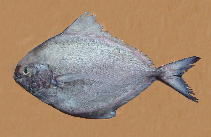| Family: |
Carangidae (Jacks and pompanos), subfamily: Caranginae |
| Max. size: |
75 cm TL (male/unsexed) |
| Environment: |
reef-associated; brackish; marine; depth range 15 - 105 m, amphidromous |
| Distribution: |
Indo-West Pacific: East Africa to southern Japan and Australia. |
| Diagnosis: |
Dorsal spines (total): 2-6; Dorsal soft rays (total): 41-46; Anal spines: 2-2; Anal soft rays: 35-40; Vertebrae: 24-24. Deep-bodied and strongly compressed fishes. Lateral line ends in weakly-developed scutes on the caudal peduncle. Pelvic fins lost in individuals over 9 cm. Color is brown above, silvery-white below. The anterior parts of the dorsal and anal fins bluish-gray. The other fins yellowish. |
| Biology: |
Adults inhabit coastal areas with muddy substrate. Found near the bottom during daytime and near the surface at night. They also enter estuaries (Ref. 1479). Normally form large schools (Ref. 5213). Swim on its side near the surface (Ref. 3197). Feed on zooplankton (Ref. 30573). Excellent food fish (Ref. 3197); marketed fresh, may be dried or salted (Ref. 5284). |
| IUCN Red List Status: |
Least Concern (LC); Date assessed: 17 July 2017 Ref. (130435)
|
| Threat to humans: |
harmless |
Source and more info: www.fishbase.org. For personal, classroom, and other internal use only. Not for publication.

